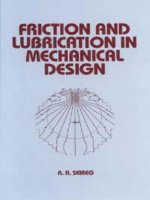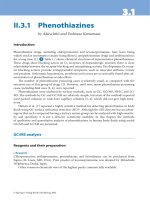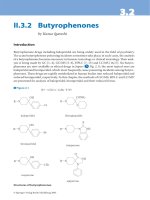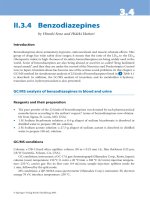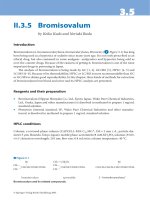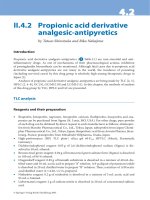Tài liệu PROBLEMS AND SOLUTIONS IN MECHANICAL ENGINEERING doc
Bạn đang xem bản rút gọn của tài liệu. Xem và tải ngay bản đầy đủ của tài liệu tại đây (4.65 MB, 529 trang )
This page
intentionally left
blankCopyright © 2007, New Age International (P) Ltd., Publishers
Published by New Age International (P) Ltd., Publishers
All rights reserved.
No part of this ebook may be reproduced in any form, by photostat, microfilm,
xerography, or any other means, or incorporated into any information retrieval
system, electronic or mechanical, without the written permission of the publisher.
All inquiries should be emailed to
PUBLISHING FOR ONE WORLD
NEW AGE INTERNATIONAL (P) LIMITED, PUBLISHERS
4835/24, Ansari Road, Daryaganj, New Delhi - 110002
Visit us at www.newagepublishers.com
ISBN (13) : 978-81-224-2551-2
Preface
Mechanical Engineering being core subject of engineering and Technology, is taught to almost all branches
of engineering, throughout the world. The subject covers various topics as evident from the course content,
needs a compact and lucid book covering all the topics in one volume. Keeping this in view the authors
have written this book, basically covering the cent percent syllabi of Mechanical Engineering (TME-
102/TME-202) of U.P. Technical University, Lucknow (U.P.), India.
From 2004–05 Session UPTU introduced the New Syllabus of Mechanical Engineering which covers
Thermodynamics, Engineering Mechanics and Strength of Material. Weightage of thermodynamics is 40%,
Engineering Mechanics 40% and Strength of Material 20%. Many topics of Thermodynamics and Strength
of Material are deleted from the subject which were included in old syllabus but books available in the
market give these useless topics, which may confuse the students. Other books cover 100% syllabus of this
subject but not covers many important topics which are important from examination point of view. Keeping
in mind this view this book covers 100% syllabus as well as 100% topics of respective chapters.
The examination contains both theoretical and numerical problems. So in this book the reader gets
matter in the form of questions and answers with concept of the chapter as well as concept for numerical
solution in stepwise so they don’t refer any book for Concept and Theory.
This book is written in an objective and lucid manner, focusing to the prescribed syllabi. This book
will definitely help the students and practicising engineers to have the thorough understanding of the
subject.
In the present book most of the problems cover the Tutorial Question bank as well as Examination
Questions of U.P. Technical University, AMIE, and other Universities have been included. Therefore, it is
believed that, it will serve nicely, our nervous students with end semester examination. Critical suggestions
and modifications by the students and professors will be appreciated and accorded
Dr. U.K. Singh
Manish Dwivedi
Feature of book
1. Cover 100% syllabus of TME 101/201.
2. Cover all the examination theory problems as well as numerical problems of thermodynamics, mechanics
and strength of materials.
3. Theory in the form of questions – Answers.
4. Included problems from Question bank provided by UPTU.
5. Provided chapter-wise Tutorials sheets.
6. Included Mechanical Engineering Lab manual.
7. No need of any other book for concept point of view.
This page
intentionally left
blank
This page
intentionally left
blank
IMPORTANT CONVERSION/FORMULA
1. Sine Rule
R
Q
P
O
180–
γ
180–
α
α
180–
β
γ
sin(180 ) sin(180 ) sin(180 )
PQR
==
−α −β −γ
2. Important Conversion
1 N = 1 kg X 1 m/sec
2
= 1000 gm X 100 cm/sec
2
g = 9.81 m/sec
2
1 H.P. = 735.5 KW
1 Pascal(Pa) = 1N/m
2
1KPa = 10
3
N/m
2
1MPa = 10
6
N/m
2
1GPa = 10
9
N/m
2
1 bar = 10
5
N/m
2
3. Important Trigonometrical Formulas
1. sin (A + B) = sin A.cos B + cos A.sin B
2. sin (A – B) = sin A.cos B - cos A.sin B
3. cos (A + B) = cos A.cos B – sin A.sin B
4. cos (A – B) = cos A.cos B + sin A.sin B
5. tan (A + B) = (tan A + tan B)/(1 – tan A. tan B)
6. tan (A – B) = (tan A – tan B)/(1 + tan A. tan B)
7. sin2 A = 2sin A.cos A
8. sin
2
A + cos
2
A = 1
9. 1 + tan
2
A = sec
2
A
10.1 + cot
2
A = cosec
2
A
11.1 + cosA = 2cos
2
A/2
intentionally left
blank
CONTENTS
Preface v
Syllabus
Important Conversion/Formula
Part– A: Thermodynamics (40 Marks)
1. Fundamental concepts, definitions and zeroth law 1
2. First law of thermodynamics 30
3. Second law 50
4. Introduction of I.C. engines 65
5. Properties of steam and thermodynamics cycle 81
Part – B: Engineering Mechanics (40 Marks)
6. Force : Concurrent Force system 104
7. Force : Non Concurrent force system 141
8. Force : Support Reaction 166
9. Friction 190
10. Application of Friction: Belt Friction 216
11. Law of Motion 242
12. Beam 265
13. Trusses 302
Part – C: Strength of Materials (20 Marks)
14. Simple stress and strain 331
15. Compound stress and strains 393
16. Pure bending of beams 409
17. Torsion 432
Appendix
1. Appendix Tutorials Sheets 448
2. Lab Manual 474
3. Previous year question papers (New syllabus) 503
This page
intentionally left
blank
Fundamental Concepts, Definitions and Zeroth Law / 1
CHAPTER
1
FUNDAMENTAL CONCEPTS, DEFINITIONS
AND ZEROTH LAW
Q. 1: Define thermodynamics. Justify that it is the science to compute energy, exergy and entropy.
(Dec–01, March, 2002, Jan–03)
Sol : Thermodynamics is the science that deals with the conversion of heat into mechanical energy. It is
based upon observations of common experience, which have been formulated into thermodynamic laws.
These laws govern the principles of energy conversion. The applications of the thermodynamic laws and
principles are found in all fields of energy technology, notably in steam and nuclear power plants, internal
combustion engines, gas turbines, air conditioning, refrigeration, gas dynamics, jet
propulsion, compressors,
chemical process plants, and direct energy conversion devices.
Generally thermodynamics contains four laws;
1. Zeroth law: deals with thermal equilibrium and establishes a concept of temperature.
2. The First law: throws light on concept of internal energy.
3. The Second law: indicates the limit of converting heat into work and introduces the principle of
increase of entropy.
4. Third law: defines the absolute zero of entropy.
These laws are based on experimental observations and have no mathematical proof. Like all physical
laws, these laws are based on logical reasoning.
Thermodynamics is the study of energy, energy and entropy.
The whole of heat energy cannot be converted into mechanical energy by a machine. Some portion of
heat at low temperature has to be rejected to the environment.
The portion of heat energy, which is not available for conversion into work, is measured by entropy.
The part of heat, which is available for conversion into work, is called energy.
Thus, thermodynamics is the science, which computes energy, energy and entropy.
Q. 2: State the scope of thermodynamics in thermal engineering.
Sol: Thermal engineering is a very important associate branch of mechanical, chemical, metallurgical,
aerospace, marine, automobile, environmental, textile engineering, energy technology, process engineering
of pharmaceutical, refinery, fertilizer, organic and inorganic chemical plants. Wherever there is combustion,
heating or cooling, exchange of heat for carrying out chemical reactions, conversion of heat into work for
producing mechanical or electrical power; propulsion of rockets, railway engines, ships, etc., application
of thermal engineering is required. Thermodynamics is the basic science of thermal engineering.
Q. 3: Discuss the applications of thermodynamics in the field of energy technology.
2 / Problems and Solutions in Mechanical Engineering with Concept
Sol: Thermodynamics has very wide applications as basis of thermal engineering. Almost all process and
engineering industries, agriculture, transport, commercial and domestic activities use thermal engineering.
But energy technology and power sector are fully dependent on the laws of thermodynamics.
For example:
(i) Central thermal power plants, captive power plants based on coal.
(ii) Nuclear power plants.
(iii) Gas turbine power plants.
(iv) Engines for automobiles, ships, airways, spacecrafts.
(v) Direct energy conversion devices: Fuel cells, thermoionic, thermoelectric engines.
(vi) Air conditioning, heating, cooling, ventilation plants.
(vii) Domestic, commercial and industrial lighting.
(viii) Agricultural, transport and industrial machines.
All the above engines and power consuming plants are designed using laws of thermodynamics.
Q. 4: Explain thermodynamic system, surrounding and universe. Differentiate among open system,
closed system and an isolated system. Give two suitable examples of each system. (Dec. 03)
Or
Define and explain a thermodynamic system. Differentiate between various types of
thermodynamic systems and give examples of each of them. (Feb. 2001)
Or
Define Thermodynamics system, surrounding and universe. (May–03)
Or
Define closed, open and isolated system, give one example of each. (Dec–04)
Sol: In thermodynamics the system is defined as the quantity of matter or region in space upon which the
attention is concentrated for the sake of analysis. These systems are also referred to as thermodynamics
system.
It is bounded by an arbitrary surface called boundary. The boundary may be real or imaginary, may
be at rest or in motion and may change its size or shape.
Everything out side the arbitrary selected boundaries of the system is called surrounding or
environment.
S
u
r
r
o
u
n
d
i
n
g
s
S
u
r
r
o
u
n
d
i
n
g
s
Boundary
System
Cylinder
Convenient
imaginary
boundary
System
Real
boundary
Piston
Piston
Fig. 1.1 The system Fig. 1.2 The real and imaginary boundaries
The union of the system and surrounding is termed as universe.
Universe = System + Surrounding
Fundamental Concepts, Definitions and Zeroth Law / 3
Types of system
The analysis of thermodynamic processes includes the study of the transfer of mass and energy across the
boundaries of the system. On the basis the system may be classified mainly into three parts.
(1) Open system (2) Closed System (3) Isolated system
(1) Open system
The system which can exchange both the mass and energy (Heat and work) with its surrounding. The mass
within the system may not be constant. The nature of the processes occurring in such system is flow type.
For example
1. Water Pump: Water enters at low level and pumped to a higher level, pump being driven by an
electric motor. The mass (water) and energy (electricity) cross the boundary of the system (pump and motor).
Mass in
Mass Out
Mass may
change
Boundary
free to
move
Heat Transfer
Work Transfer
Fig. 1.3
2.Scooter engine: Air arid petrol enter and burnt gases leave the engine. The engine delivers mechanical
energy to the wheels.
3. Boilers, turbines, heat exchangers. Fluid flow through them and heat or work is taken out or
supplied to them.
Most of the engineering machines and equipment are open systems.
(2) Closed System
The system, which can exchange energy with their surrounding but not the mass. The quantity of matter
thus remains fixed. And the system is described as control mass system.
The physical nature and chemical composition of the mass of the system may change.
Water may evaporate into steam or steam may condense into water. A chemical reaction may occur
between two or more components of the closed system.
For example
1. Car battery, Electric supply takes place from and to the battery but there is no material transfer.
2. Tea kettle, Heat is supplied to the kettle but mass of water remains constant.
Mass may
change
Boundary
free to
move
Heat Transfer
Work Transfer
Fig 1.4
3. Water in a tank
4. Piston – cylinder assembly.
(3) Isolated System
In an Isolated system, neither energy nor masses are allowed to cross the boundary. The system has fixed mass
and energy. No such system physically exists. Universe is the only example, which is perfectly isolated system.
4 / Problems and Solutions in Mechanical Engineering with Concept
Other Special System
1. Adiabatic System: A system with adiabatic walls can only exchange work and not heat with the
surrounding. All adiabatic systems are thermally insulated from their surroundings.
Example is Thermos flask containing a liquid.
2. Homogeneous System: A system, which consists of a single phase, is termed as homogeneous
system. For example, Mi×ture of air and water vapour, water plus nitric acid and octane plus heptanes.
3. Hetrogeneous System: A system, which consists of two or more phase, is termed as heterogeneous
system. For example, Water plus steam, Ice plus water and water plus oil.
Q. 5: Classified each of the following systems into an open or closed systems.
(1) Kitchen refrigerator, (2) Ceiling fan (3) Thermometer in the mouth (4) Air compressor
(5) Pressure Cooker (6) Carburetor (7) Radiator of an automobile.
(1) Kitchen refrigerator: Closed system. No mass flow. Electricity is supplied to compressor motor
and heat is lost to atmosphere.
(2) Ceiling fan: Open system. Air flows through the fan. Electricity is supplied to the fan.
(3) Thermometer in the mouth: Closed system. No mass flow. Heat is supplied from mouth to
thermometer bulb.
(4) Air compressor: Open system. Low pressure air enters and high pressure air leaves the compressor,
electrical energy is supplied to drive the compressor motor.
(5) Pressure Cooker: Closed system. There is no mass exchange (neglecting small steam leakage).
Heat is supplied to the cooker.
(6) Carburetor: Open system. Petrol and air enter and mi×ture of petrol and air leaves the carburetor.
There is no change of energy.
(7) Radiator of an automobile: Open system. Hot water enters and cooled water leaves the radiator.
Heat energy is extracted by air flowing over the outer surface of radiator tubes.
Q. 6: Define Phase.
Sol: A phase is a quantity of matter, which is homogeneous throughout in chemical composition and
physical structure.
If the matter is all gas, all liquid or all solid, it has physical uniformity. Similarly, if chemical composition
does not vary from one part of the system to another, it has chemical uniformity.
Examples of one phase system are a single gas, a single liquid, a mi×ture of gases or a solution of
liquid contained in a vessel.
A system consisting of liquid and gas is a two–phase system.
Water at triple point exists as water, ice and steam simultaneously forms a three–phase system.
Q. 7: Differentiate between macroscopic and microscopic approaches. Which approach is used in
the study of engineering thermodynamics. (Sept. 01; Dec., 03, 04)
Or
Explain the macroscopic and microscopic point of view.Dec–2002
Sol: Thermodynamic studies are undertaken by the following two different approaches.
l. Macroscopic approach–(Macro mean big or total)
2. Microscopic approach–(Micro means small)
The state or condition of the system can be completely described by measured values of pressure,
temperature and volume which are called macroscopic or time–averaged variables. In the classical
Fundamental Concepts, Definitions and Zeroth Law / 5
thermodynamics, macroscopic approach is followed. The results obtained are of sufficient accuracy and
validity.
Statistical thermodynamics adopts microscopic approach. It is based on kinetic theory. The matter
consists of a large number of molecules, which move, randomly in chaotic fashion. At a particular moment,
each molecule has a definite position, velocity and energy. The characteristics change very frequently due
to collision between molecules. The overall behaviour of the matter is predicted by statistically averaging
the behaviour of individual molecules.
Microscopic view helps to gain deeper understanding of the laws of thermodynamics. However, it is
rather complex, cumbersome and time consuming. Engineering thermodynamic analysis is macroscopic and
most of the analysis is made by it.
These approaches are discussed (in a comparative way) below:
Macroscopic approach Microscopic approach
1. In this approach a certain quantity of
matter is considered without taking into
account the events occurring at molecular
level. In other words this approach to
thermodynamics is concerned with gross
or overall behaviour. This is known as
classical thermodynamics.
2. The analysis of macroscopic system
requires simple mathematical formulae.
3. The values of the properties of the system
are their average values. For example,
consider a sample of a gas in a closed
container. The pressure of the gas is the
average value of the pressure exerted by
millions of individual molecules.
Similarly the temperature of this gas is
the average value of transnational kinetic
energies of millions of individual
molecules. these properties like pressure
and temperature can be measured very
easily. The changes in properties can be
felt by our senses.
4. In order to describe a system only a few
properties are needed.
1. The approach considers that the system
is made up of a very large number of
discrete particles known as molecules.
These molecules have different velocities
and energies. The values of these energies
are constantly changing with time. This
approach to thermodynamics, which is
concerned directly with the structure of
the matter, is known as statistical
thermodynamics.
2. The behaviour of the system is found by
using statistical methods, as the number
of molecules is very large. so advanced
statistical and mathematical methods are
needed to explain the changes in the
system.
3. The properties like velocity, momentum,
impulse, kinetic energy, and instruments
cannot easily measure force of impact etc.
that describe the molecule. Our senses
cannot feel them.
4. Large numbers of variables are needed
to describe a system. So the approach is
complicated.
6 / Problems and Solutions in Mechanical Engineering with Concept
Q. 8: Explain the concept of continuum and its relevance in thermodynamics. Define density and
pressure using this concept. (June, 01, March– 02, Jan–03)
Or
Discuss the concept of continuum and its relevance. (Dec–01)
Or
Discuss the concept of continuum and its relevance in engineering thermodynamics. (May–02)
Or
What is the importance of the concept of continuum in engineering thermodynamics. (May–03)
Sol: Even the simplification of matter into molecules, atoms, electrons, and so on, is too complex a picture
for many problems of thermodynamics. Thermodynamics makes no hypotheses about the structure of the
matter of the system. The volumes of the system considered are very large compared to molecular dimensions.
The system is regarded as a continuum. The system is assumed to contain continuous distribution of matter.
There are no voids and cavities. The pressure, temperature, density and other properties are the average
values of action of many molecules and atoms. Such idealization is a must for solving most problems. The
laws and concepts of thermodynamics are independent of structure of matter.
According to this concept there is minimum limit of volume upto which the property remain continuum.
Below this volume, there is sudden change in the value of the property. Such a region is called region of
discrete particles and the region for which the property are maintain is called region of continuum. The
limiting volume up to which continuum properties are maintained is called continuum limit.
For Example: If we measure the density of a substance for a large volume (υ
1
), the value of density is (ρ
1
).
If we go on reducing the volume by δv’, below which the ratio äm/äv deviates from its actual value and
the value of äm/äv is either large or small.
Thus according to this concept the design could be defined as
ρ = lim δv– δv’ [δm / δv]
()a
Volume of the system
()b
Case II
A
C
B
d V
d V
Case I
Region of
continnum
Region of
non-continnum
Average mass density
System
d m
d
r =
d V
d m
Fig 1.5
Q. 9: Define different types of properties?
Sol: For defining any system certain parameters are needed. Properties are those observable characteristics
of the system, which can be used for defining it. For example pressure, temp, volume.
Properties further divided into three parts;
Fundamental Concepts, Definitions and Zeroth Law / 7
Intensive Properties
Intensive properties are those, which have same value for any part of the system or the properties that are
independent of the mass of the system. EX; pressure, temp.
Extensive Properties
EXtensive properties are those, which dependent Upon the mass of the system and do not maintain the same
value for any part of the system. EX; mass, volume, energy, entropy.
Specific Properties
The extensive properties when estimated on the unit mass basis result in intensive property, which is also
known as specific property. EX; sp. Heat, sp. Volume, sp. Enthalpy.
Q. 10: Define density and specific volume.
Sol: DENSITY (ρ)
Density is defined as mass per unit volume;
Density = mass/ volume; ρ = m/v, kg/m
3
P for Hg = 13.6 × 10
3
kg/m
3
ρ for water = 1000 kg/m
3
Specific Volume (
νν
νν
ν)
It is defined as volume occupied by the unit mass of the system. Its unit is m
3
/kg. Specific volume is
reciprocal of density.
ν = v/m; m
3
/kg
Q. 11: Differentiate amongst gauge pressure, atmospheric pressure and absolute pressure. Also give
the value of atmospheric pressure in bar and mm of Hg. (Dec–02)
Sol: While working in a system, the thermodynamic medium exerts a force on boundaries of the vessel in
which it is contained. The vessel may be a container, or an engine cylinder with a piston etc. The exerted
force F per unit area A on a surface, which is normal to the force, is called intensity of pressure or simply
pressure p. Thus
P = F/A= ρ.g.h
It is expressed in Pascal (1 Pa = 1 Nm
2
),
bar (1 bar = 10
5
Pa),
standard atmosphere (1 atm =1.0132 bar),
or technical atmosphere (1 kg/cm
2
or 1 atm).
1 atm means 1 atmospheric absolute.
The pressure is generally represented in following terms.
1. Atmospheric pressure
2. Gauge pressure
3. Vacuum (or vacuum pressure)
4. Absolute pressure
Atmospheric Pressure (P
atm
)
It
is the pressure exerted by atmospheric air on any surface. It is measured by a barometer. Its standard
values are;
1 P
atm
= 760 mm of Hg i.e. column or height of mercury
= ρ.g.h. = 13.6 × 10
3
× 9.81 × 760/1000
8 / Problems and Solutions in Mechanical Engineering with Concept
= 101.325 kN/m
2
= 101.325 kPa
= 1.01325 bar
when the density of mercury is taken as 13.595 kg/m
3
and acceleration due to gravity as 9.8066 m/s
2
Gauge Pressure (P
gauge
)
It is the pressure of a fluid contained in a closed vessel. It is always more than atmospheric pressure. It
is measured by an instrument called pressure gauge (such as Bourden’s pressure gauge). The gauge measures
pressure of the fluid (liquid and gas) flowing through a pipe or duct, boiler etc. irrespective of prevailing
atmospheric pressure.
Vacuum (Or Vacuum pressure) (P
vacc
)
It is the pressure of a fluid, which is always less than atmospheric pressure. Pressure (i.e. vacuum) in a
steam condenser is one such example. It is also measured by a pressure gauge but the gauge reads on
negative side of atmospheric pressure on dial. The vacuum represents a difference between absolute and
atmospheric pressures.
Absolute Pressure (P
abs
)
It is that pressure of a fluid, which is measured with respect to absolute zero pressure as the reference.
Absolute zero pressure can occur only if the molecular momentum is zero, and this condition arises when
there is a perfect vacuum. Absolute pressure of a fluid may be more or less than atmospheric depending
upon, whether the gauge pressure is expressed as absolute pressure or the vacuum pressure.
Inter–relation between different types of pressure representations. It is depicted in Fig. 1.6, which can
be expressed as follows.
p
abs
= p
atm
+ p
gauge
p
abs
= p
atm
– p
vace
1.0132 bar
= 1.0132 bar
= 0 bar
P
gauge
P
atm
P
abs
P
abs
P
vacc
Gauge pressure line
Atmospheric pressure line
Absolute zero pressure line
Fig 1.6 Depiction of atmospheric, gauge, vacuum, and absolute pressures and their interrelationship.
Hydrostatic Pressure
Also called Pressure due to Depth of a Fluid. It is required to determine the pressure exerted by a static
fluid column on a surface, which is drowned under it. Such situations arise in water filled boilers, petrol
or diesel filled tank in IC engines, aviation fuel stored in containers of gas turbines etc.
This pressure is also called ‘hydrostatic pressure’ as it is caused due to static fluid. The hydrostatic pressure
acts equally in all directions on lateral surface of the tank. Above formula holds good for gases also. But
due to a very small value of p (and w), its effect is rarely felt. Hence, it is generally neglected in thermodynamic
calculations. One such tank is shown in Fig. 1.7. It contains a homogeneous liquid of weight density w. The
pressure p exerted by it at a depth h will be given by
Fundamental Concepts, Definitions and Zeroth Law / 9
h
p=wh
Fig 1.7 Pressure under depth of a fluid increases with increase in depth.
Q. 12: Write short notes on State, point function and path function.
STATE
The State of a system is its condition or configuration described in sufficient detail.
State is the condition of the system identified by thermodynamic properties such as pressure, volume,
temperature, etc. The number of properties required to describe a system depends upon the nature of the
system. However each property has a single value at each state. Each state can be represented by a point
on a graph with any two properties as coordinates.
Any operation in which one or more of properties of a system change is called a change of state.
Point Function
A point function is a single valued function that always possesses a single – value is all states. For example
each of the thermodynamics properties has a single – value in equilibrium and other states. These properties
are called point function or state function.
Or
when two properties locate a point on the graph ( coordinates axes) then those properties are called as point
function.
For example pressure, volume, temperature, entropy, enthalpy, internal energy.
Path Function
Those properties, which cannot be located on a graph by a point but are given by the area or show on the
graph.
A path function is different from a point function. It depends on the nature of the process that can
follow different paths between the same states. For example work, heat, heat transfer.
Q. 13: Define thermodynamic process, path, cycle.
Sol: Thermodynamic system undergoes changes due to the energy and mass interactions. Thermody-namic
state of the system changes due to these interactions.
The mode in which the change of state of a system takes place is termed as the PROCESS such as
constant pressure, constant volume process etc. In fig 1.8, process 1–2 & 3–4 is constant pressure process
while 2–3 & 4–1 is constant volume process.
Let us take gas contained in a cylinder and being heated up. The heating of gas in the cylinder shall
result in change in state of gas as it’s pressure, temperature etc. shall increase. However, the mode in which
this change of state in gas takes place during heating shall he constant volume mode and hence the process
shall be called constant volume heating process.
The PATH refers to the series of state changes through which the system passes during a process.
Thus, path refers to the locii of various intermediate states passed through by a system during a process.
CYCLE refers to a typical sequence of processes in such a fashion that the initial and final states are
identical. Thus, a cycle is the one in which the processes occur one after the other so as to finally, land
10 / Problems and Solutions in Mechanical Engineering with Concept
the system at the same state. Thermodynamic path in a cycle is in closed loop
form. After the occurrence of a cyclic process, system shall show no sign of the
processes having occurred. Mathematically, it can be said that the cyclic integral
of any property in a cycle is zero.
1–2 & 3–4 = Constant volume Process
2–3 &4–1 = Constant pressure Process
1–2, 2–3, 3–4 & 4–1 = Path
1–2–3–4–1 = Cycle Fig 1.8
Q. 14: Define thermodynamic equilibrium of a system and state its importance. What are the conditions
required for a system to be in thermodynamic equilibrium? Describe in brief.
(March–02, Dec–03)
Or
What do you known by thermodynamic equilibrium. (Dec–02, Dec–04, may–05, Dec–05)
Sol: Equilibrium is that state of a system in which the state does not undergo any change in itself with
passage of time without the aid of any external agent. Equilibrium state of a system can be examined by
observing whether the change in state of the system occurs or not. If no change in state of system occurs
then the system can be said in equilibrium.
Let us consider a steel glass full of hot milk kept in open atmosphere. It is quite obvious that the heat
from the milk shall be continuously transferred to atmosphere till the temperature of milk, glass and
atmosphere are not alike. During the transfer of heat from milk the temperature of milk could be seen to
decrease continually. Temperature attains some final value and does not change any more. This is the
equilibrium state at which the properties stop showing any change in themselves.
Generally, ensuring the mechanical, thermal, chemical and electrical equilibriums of the system may
ensure thermodynamic equilibrium of a system.
1. Mechanical Equilibrium: When there is no unbalanced force within the system and nor at its
boundaries then the system is said to be in mechanical equilibrium.
For a system to be in mechanical equilibrium there should be no pressure gradient within the system
i.e., equality of pressure for the entire system.
2. Chemical Equilibrium: When there is no chemical reaction taking place in the system it is said
to be in chemical equilibrium.
3. Thermal equilibrium: When there is no temperature gradient within the system, the system is said
to be in thermal equilibrium.
4. Electrical Equilibrium: When there is no electrical potential gradient within a system, the system
is said to be in electrical equilibrium.
When all the conditions of mechanical, chemical thermal, electrical equilibrium are satisfied, the
system is said to be in thermodynamic equilibrium.
Q. 15: What do you mean by reversible and irreversible processes? Give some causes of irreversibility.
(Feb–02, July–02)
Or
Distinguish between reversible and irreversible process (Dec–01, May–02)
Or
Briefly state the important features of reversible and irreversible processes. (Dec–03)
Sol: Thermodynamic system that is capable of restoring its original state by reversing the factors responsible
for occurrence of the process is called reversible system and the thermodynamic process involved is called
reversible process.
p
v
4
1
23
Fundamental Concepts, Definitions and Zeroth Law / 11
Thus upon reversal of a process there shall be no trace of the process being occurred, i.e., state changes
during the forward direction of occurrence of a process are exactly similar to the states passed through by
the system during the reversed direction of the process.
1- 2 = Reversible process following
equilibrium states
3- 4 = Irreversible process following
non-equilibrium states
p
V
2
1
3
4
Fig. 1.9. Reversible and irreversible processes
It is quite obvious that such reversibility can be realised only if the system maintains its thermodynamic
equilibrium throughout the occurrence of process.
Irreversible systems are those, which do not maintain equilibrium during the occurrence of a process.
Various factors responsible for the non–attainment of equilibrium are generally the reasons responsible for
irreversibility Presence of friction, dissipative effects etc.
Q. 16: What do you mean by cyclic and quasi – static process. (March–02, Jan–03, Dec–01, 02, 05)
Or
Define quasi static process. What is its importance in study of thermodynamics. (May–03)
Sol: Thermodynamic equilibrium of a system is very difficult to be realised during the occurrence of a
thermodynamic process. ‘Quasi–static’ consideration is one of the ways to consider the real system as if
it is behaving in thermodynamic equilibr
i
um and thus permitting the thermodynamic study. Actually system
does not attain thermodynamic equilibrium, only certain assumptions make it akin to a system in equilibrium
for the sake of study and analysis.
Quasi–static literally refers to “almost static” and the infinite slowness of the occurrence of a process
is considered as the basic premise for attaining near equilibrium in the system. Here it is considered that
the change in state of a system occurs at infinitely slow pace, thus consuming very large time for completion
of the process. During the dead slow rate of state change the magnitude of change in a state shall also be
infinitely small. This infinitely small change in state when repeatedly undertaken one after the other results
in overall state change but the number of processes required for completion of this state change are infinitely
large. Quasi–static process is presumed to remain in thermodynamic equilibrium just because of infinitesimal
state change taking place during the occurrence of the process. Quasi–static process can be understood from
the following example.
Weight
Lid
Gas
Heating
v
p
W
×××××××××××
1 = Initial state
2 = Final state
Intermediate
equilibrium states
Fig 1.9 Quasi static process
12 / Problems and Solutions in Mechanical Engineering with Concept
Let us consider the locating of gas in a container with certain mass ‘W’ kept on the top lid (lid is such
that it does not permit leakage across its interface with vessel wall) of the vessel as shown in Fig. 1.9. After
certain amount of heat being added to the gas it is found that the lid gets raised up. Thermodynamic state
change is shown in figure. The “change in state”, is significant.
During the “change of state” since the states could not be considered to be in equilibrium, hence for
unsteady state of system, thermodynamic analysis could not be extended. Difficulty in thermody-namic
analysis of unsteady state of system lies in the fact that it is not sure about the state of system as it is
continually changing and for analysis one has to start from some definite values.
Let us now assume that the total mass comprises of infinitesimal small masses of ‘w’ such that all ‘w’
masses put together become equal to w. Now let us start heat addition to vessel and as soon as the lifting
of lid is observed put first fraction mass `w’ over the lid so as to counter the lifting and estimate the state
change. During this process it is found that the state change is negligible. Let us further add heat to the
vessel and again put the second fraction mass ‘w’ as soon as the lift is felt so as to counter it. Again the
state change is seen to be negligible. Continue with the above process and at the end it shall be seen that
all fraction masses ‘w’ have been put over the lid, thus amounting to mass ‘w’ kept over the lid of vessel
and the state change occurred is exactly similar to the one which occurred when the mass kept over the lid
was `W’. In this way the equilibrium nature of system can be maintained and the thermodynamic analysis
can be carried out. P–V representation for the series of infinitesimal state changes occurring between states
1 & 2 is also shown in figure 1.9.
Note:
In PV = R
0
T, R
0
= 8314 KJ/Kgk
And in PV = mRT; R = R
0
/M; Where M = Molecular Weight
Q. 17: Convert the following reading of pressure to kPa, assuming that the barometer reads 760mm Hg.
(1) 90cm Hg gauge (2) 40cm Hg vacuum (3) 1.2m H
2
O gauge
Sol: Given that h = 760mm of Hg for P
atm
P
atm
= ρgh = 13.6 × 10
3
× 9.81 × 760/1000 = 101396.16
N/m
2
= 101396.16Pa = 101.39KPa (i)
(a) 90cm Hg gauge
P
gauge
= ρgh = 13.6 × 10
3
× 9.81 × 90/100 = 120.07KPa (ii)
P
abs
= P
atm
+ P
gauge
= 101.39 + 120.07
P
abs
= 221.46KPa ANS
(b) 40cm Hg vacuum
P
vacc
= ρgh = 13.6 × 10
3
× 9.81 × 40/100 = 53.366KPa (iii)
P
abs
= P
atm
– P
vacc
= 101.39 – 53.366
P
abs
= 48.02KPa ANS
(c)1.2m Water gauge
P
gauge
= ρgh = 1000 × 9.81 × 1.2 = 11.772KPa (iv)
P
abs
= P
atm
+ P
gauge
= 101.39 + 11.772
P
abs
= 113.162KPa ANS

